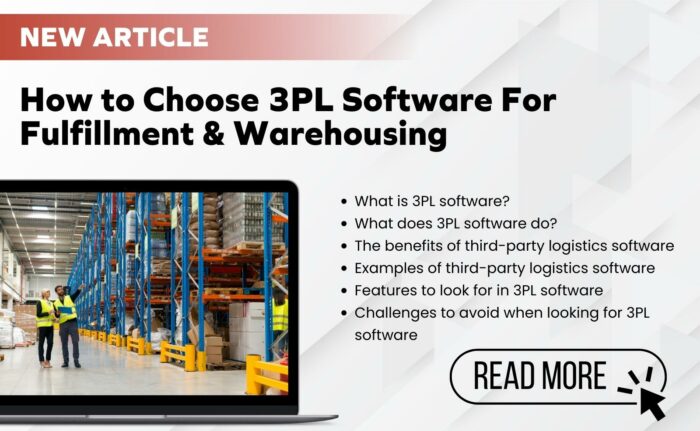
As worldwide annual retail e-commerce sales surpass $6 trillion, savvy brands and their 3PL partners are focused on optimizing their omnichannel fulfillment operations. In order to take advantage of the incredible growth opportunities, these retail brands need to adjust their operations to be more flexible and automated, partnering with a best-in-class omnichannel and e-commerce warehouse management system to unlock greater efficiencies and productivity.
Yet, the path to successful omnichannel operations is not without its hurdles. As operations embark on this transformative journey, they must be prepared to navigate a series of challenges. In this post, we dive into top challenges e-commerce operators face, the benefits of a great WMS, and key features to look for in your next solution:
- What is an e-commerce warehouse management system (WMS)?
- Common challenges for e-commerce warehouses
- How to choose the right e-commerce warehouse management system: key features to look for
What is an E-commerce Warehouse Management System (WMS)?
A warehouse management system (WMS) helps operators optimize and manage the daily operations within a distribution center (DC), and serves as the backbone of operations, orchestrating inventory, orders, and fulfillment across various channels. WMS software powers how warehouses receive inventory, how they put away and store that product, and how they pick that inventory to fulfill orders in the most timely and efficient method.
(Learn more about the importance of a warehouse management system here.)
The insides of a warehouse are often built specifically to optimize storage and fulfillment of certain types of product or specific customers. For example, if a facility receives and ships full pallets only, the warehouse would likely be optimized to store as many pallets as possible to increase efficiency and square footage, and possibly have cross dock capabilities.
E-commerce fulfillment, on the other hand, has a unique set of needs. In contrast, an e-commerce facility or hybrid facility would need to be laid out and optimized for managing high volumes of smaller orders, picking and shipping “eaches” or a small number of SKUs, have a large shipping area for boxing, packaging and labeling, and integrate with parcel carriers. E-commerce facilities need to be optimized with powerful pick and pack software for quick order assembly, value added services, staging parcel carrier pickup, etc.
Top WMS systems can be customized to power a wide-range of operations effectively and efficiently. If you’re looking for an omnichannel and e-commerce warehouse management system—including both B2B and e-commerce fulfillment—make sure to consider these potential challenges, important features, and best practices.
Common Challenges For E-commerce Warehouses
The WMS serves as the backbone of operational success, yet its implementation is far from uniform. Tailoring e-commerce warehouse management software to the unique complexity and business requirements of each operation is crucial. Still, within the realm of omnichannel fulfillment, several shared challenges persist.
E-commerce WMS Challenge #1: Inventory Management Complexity
Vikas Aron, Chief Product Officer at Bricz says, “Brands must plan, allocate and sell across retail, wholesale, and digital channels. They are looking to stock inventory across different channels in a single location to improve inventory efficiency and margins amidst demand and distribution volatility. However, with very different order profiles, service level agreements, picking and packing processes, the benefits of keeping inventory together can often result in higher operating costs. Managing this balance between operating costs and inventory efficiency is one of the top challenges omnichannel retailers face.”
E-commerce WMS Challenge #2: Space Utilization and Warehouse Optimization
James Goldman, CEO, and Managing Partner at JGA believes warehouse optimization and space utilization is a challenge for companies implementing omnichannel fulfillment. “With multiple channels, the warehouse’s layout needs to be optimized, and the picking and packing process needs to be streamlined to ensure timely and accurate order fulfillment. The challenge also arises in managing inventory storage and handling procedures to keep the inventory safe and secure.”
E-commerce WMS Challenge #3: Picking Complexity and Labor Shortages
Steve Hopper, Founder and Principal at Inviscid Consulting states that as a wider variety of order types becomes normal, the need to handle multiple units of measure (UOM) can complicate things. “Since omnichannel warehouses are shipping ‘ones and tons’ concurrently, the same SKU is often available at multiple UOMs. These might include a full pallet load, a full case, an inner pack, and/or an each. And the most efficient way to pick and ship orders typically involves picking the same SKU at all UOMs, depending on the quantity.”
This in turn leads to increased picking complexities, as Jason Gryszkowiec, Senior Managing Director at St. Onge cautions. “Increases in e-commerce volume and more frequent smaller deliveries to service storereplenishment drive up break case volume, increasing picking complexity and labor needs while creating new order pack and finishing task requirements. Plus, increasing SKUs stresses resources within the facility as they expand to service multiple challenges.”
E-commerce WMS Challenge #4: Staffing Challenges and Fluctuating Demand
Staffing challenges are a common thread across all warehouse environments. Steve Pullo, President at Blue Label Systems, shares that “scaling the workforce during peak periods is a serious challenge” in omnichannel environments. This is because some retail businesses can go from shipping 5k orders a day to 50k orders a day almost overnight once peak season hits.
In addition, many warehouse teams are struggling to understand how to manage warehouse employees for optimized productivity, resulting in burnt out associates, high turnover, and inefficient labor.
How to Choose the Right E-commerce Warehouse Management System: Key Features to Look For
The experts unanimously agree that a robust Warehouse Management System (WMS) tailored to the unique requirements of omnichannel operations is essential to overcoming these challenges. This modern solution not only enhances operational efficiency but also improves customer satisfaction by delivering seamless shopping experiences.
When looking for the right omnichannel and e-commerce warehouse management system, our experts indicate the following six features are critical.
- Order management – You want a WMS that allows you to intelligently aggregate multiple orders, allowing you to organize all orders that need to be shipped into smart buckets or work that are combined according to a variety of characteristics.
- Value-added Service (VAS) – VAS provides brands and their 3PL partners with a suite of services that will improve the consumer experience while growing revenue, like inserting a coupon or free gift into a shipment or providing customized wrapping and light assembly.
- Returns Processing – It’s inevitable, a portion of goods purchased online will need to be returned, which means having a simplified returns process is essential. Retail brands need to be able to provide customers with a replacement, credit, or refund, and deal with the physical goods, be it to restock and resell, or properly dispose of.
- Scale as you grow – Whether you need to expand into a new facility or add new business lines, you want a solution that accommodates that from a commercial standpoint without adding complexities down the line.
- Reliable integration – You want an omnichannel and e-commerce WMS that can create and publish endpoints that are easy to interpret, allowing you to seamlessly integrate data directly in and out of your system. A standard approach that works across a range of customers is key.
Conclusion
Omnichannel fulfillment has tremendous potential, but also poses challenges. By acknowledging and addressing issues such as inventory management, space optimization, picking intricacies, and labor shortages, operations can forge a path to success. Armed with a purpose-built omnichannel and e-commerce warehouse management system, operations are primed to transform challenges into opportunities, ensuring efficient operations and resonating with the demands of consumers who seek seamless shopping journeys across diverse channels.
For more details on transforming your supply chains to deliver omnichannel excellence, check out our white paper: Navigating the Omnichannel Frontier: Success Stories and Strategies for Seamless Shopping Experiences.


